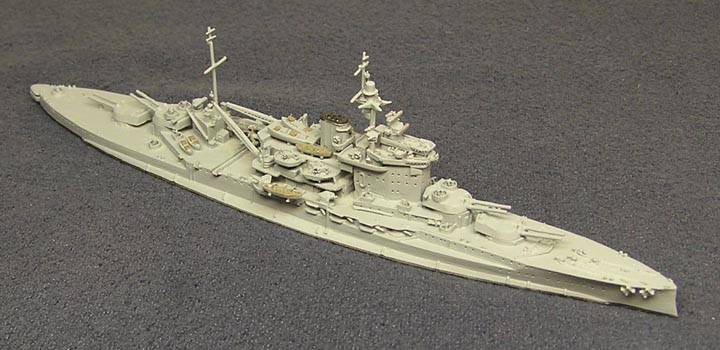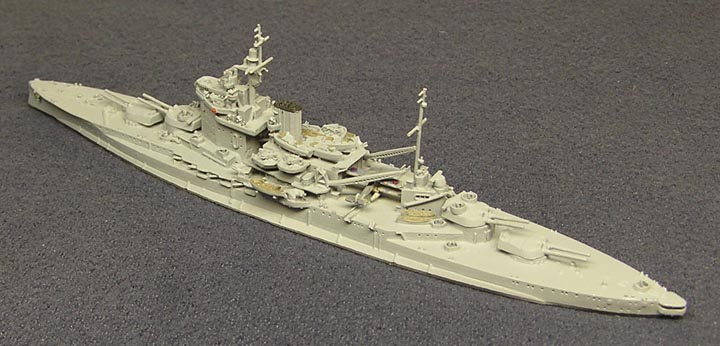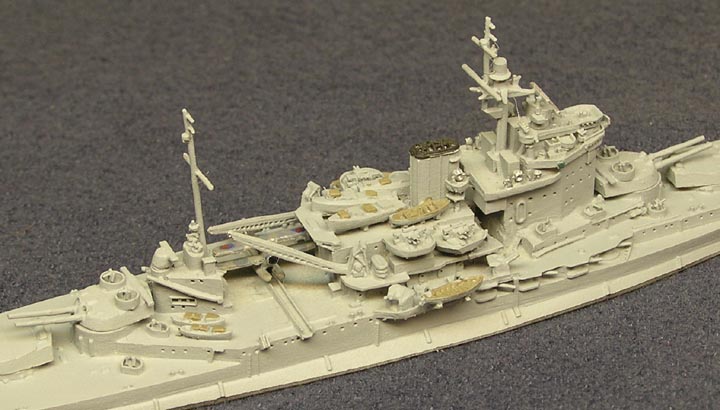H.M.S. Warspite
03

1943
(Neptun 1104b)
- Class: Queen Elizabeth - 5 battleships of 1912-13
- Displacement: 30,600 tons
- Dimensions: 600 (pp) 639.75 (oa) x 90.5 (104 outside bulges) x 30.75 ft.
- Machinery: 4-shaft geared turbines, S.H.P. 80,000 = 24 knots
- Armor: Main belt 4-6 in. (ends), 8-13 in. (amid), decks 1.25-3 in. (ends), 3.25-4 in. (amid), turrets 5-13 in., C.T. 11 in.
- Armament: 8-15 in. (4x2), 8-6 in. (8x1), 8-4 in. A.A. (4x2), 32-2 pdr. A.A. (4x8) guns; 4 aircraft
- Complement: 1,184
- Builder: Devonport Dockyard
- Laid Down: 31 Oct 1912
- Launched: 26 Nov 1913
- Commissioned: 8 Mar 1915
- Decommissioned: 1 Feb 1945
- Service: Part of 5th Battle Squadron at Jutland 1916; struck 15 times by shellfire. Reconstructed 1934-37. Mediterranean and Home fleets 1939-42, Eastern fleet 1942-43, Force "H" 1943, Home fleet and Reserve 1944-45. In response to the German invasion of Norway in Apr 1940, Warspite led nine destroyers into Ofotfjord to attack the German forces that had seized Narvik. In this Second Naval Battle of Narvik, all eight German destroyers present were sunk; in addition her Fairey Swordfish floatplane bombed and sank the German submarine U-64.
Sent to the Med just before Italy declared war, serving as flagship of Adm Cunningham. Participated in the Battle of Calabria 9 Jul 1940, scoring a hit on Italian battleship Giulio Cesare at the awesome range of 26,000 yd, leading to the retirement of Italian forces. Participated in the Battle of Cape Matapan, 28 Mar 1941, which resulted in the destruction of the Italian heavy cruisers Fiume, Pola, and Zara. Bombed off Crete 22 May; sent to USA for repairs via Suez and Pearl Harbor, she was at Bremerton when the Japanese war began. Sent back to Indian Ocean via Sydney by Mar 1942, to become Eastern Fleet flagship of Adm Somerville. Supported the British invasion of Madagascar in Sep 1942; returned to Britain in May 1943. Participated in Operation Husky, the invasion of Sicily, in Jul 1943. Escorted elements of the Italian fleet into internment at Malta following the Italian armistice of 8 Sep. Sent to Salerno to provide gunfire support for the Allied troops threatened by German counterattacks. On 16 Sep 1943 she was severely damaged by a Fritz X guided bomb; towed first to Malta for emergency repairs, and then to Gibraltar in Nov, finally returning to Britain in Mar 1944. Her 6in guns were removed; one of her boiler rooms and X turret could not be repaired, but for D-Day she could still provide 6-15in and 8-4in AA guns. First ship to open fire on 6 Jun 1944, she supported the easternmost landings at Sword Beach. After resupply at Portsmouth she moved to Utah Beach on 9 Jun and Gold Beach on 11 Jun. With worn out guns she sailed to Rosyth, striking a mine off Harwich 13 Jun. Speed reduced to 15 knots, she returned to support American forces at Brest in late Aug, and finally the Anglo-Canadian operations at Walcheren Island 1 Nov 1944 in her last action. Postwar attempts to preserve her as a museum ship failed.
Wrecked en route to Faslane for scrapping, 1947.



 Previous
Previous
 Up
Up
 Next
Next





 Previous
Previous
 Up
Up
 Next
Next